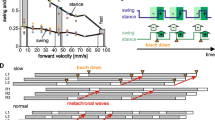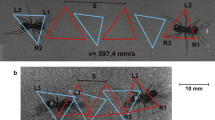Summary
Stick insects (Carausius morosus) walking on a wheel were perturbed by restricting the forward protraction of individual legs. A barrier placed before a single middle or rear leg prevented that leg from reaching its normal protraction endpoint but allowed it unimpeded retraction. Upon striking the barrier, the protracting leg attempted to get past it and thereby prolonged protraction. This prolongation increased with the extent to which the obstruction infringed upon the leg's normal step range. Barriers placed near the midpoint of this range elicited large perturbations: the blocked leg often continued its protraction throughout many step cycles of the other legs (Fig. 1 E, F). For the most part walking was irregular and smooth forward progression was disrupted. Nevertheless, the infrequent steps by the affected leg usually were coordinated with those of the adjacent ipsilateral legs.
More rostral barrier positions elicited smaller perturbations: the blocked leg usually made one step in each step cycle of the other legs (Fig. 1 B, C, D, G). Measurements for these regular step sequences showed quantitatively that protraction duration increased in proportion to the severity of the infringement on normal leg movement (Figs. 3, 4). The fraction of the step period occupied by protraction increased from ca. 10% for normal walking to ca. 50% for caudal barrier positions. This proportionality is interpreted to show the importance of spatial components of the walking program.
When one leg was obstructed, its extended protraction influenced the stepping of the three adjacent legs as follows. First, the ipsilateral rostral leg showed the largest change: its protraction onset was regularly delayed for the duration of the extended protraction (Figs. 4, 7, 8), demonstrating a strong, centrally mediated inhibition. The presence of a further delay of up to 100 to 140 ms suggests that peripheral input from the protracting leg may be important for releasing this inhibition. Second, steps by an adjacent caudal leg were not measurably affected. However, the method may not have sufficed to reveal such effects because during regular walking middle leg protractions rarely lasted long enough to conflict with subsequent steps by the ipsilateral rear leg. Third, contralateral effects differed between middle and rear leg obstructions. If the obstructed leg was a middle leg, its extended protraction had little effect upon stepping by the contralateral middle leg: the latter leg frequently protracted while the blocked leg continued its protraction and there was no consistent change in the phase relation of these two legs (Table 1). In contrast, if the obstructed leg was a rear leg, protractions by the contralateral rear leg tended to be delayed (Table 1).
Similar content being viewed by others
References
Bässler U (1972) Zur Beeinflussung der Bewegungsweise eines Beines vonCarausius morosus durch Amputation anderer Beine. Kybernetik 10:110–114
Bässler U (1977) Sensory control of leg movement in the stick insectCarausius morosus. Biol Cybern 25:61–72
Batschelet E (1965) Statistical methods for the analysis of problems in animal orientation and certain biological rhythms. AIBS Monograph
Cruse H (1979) The control of the anterior extreme position of the hindleg of a walking insect,Carausius morosus. Physiol Entomol 4:121–124
Cruse H (1980a) A quantitative model of walking incorporating central and peripheral influences. I. The control of the individual leg. Biol Cybern 37:131–136
Cruse H (1980b) A quantitative model of walking incorporating central and peripheral influences. II. The connections between the different legs. Biol Cybern 37:137–144
Cruse H, Saxler G (1980) The coordination of force oscillations and of leg movements in a walking insect (Carausius morosus). Biol Cybern 36:165–171
Forssberg H (1979) Stumbling corrective reaction: A phase-dependent compensatory reaction during locomotion. J Neurophysiol 42:936–953
Graham D (1977a) Simulation of a model for the coordination of leg movement in free walking insects. Biol Cybern 26:187–198
Graham D (1977b) The effect of amputation and leg restraint on the free walking coordination of the stick insectCarausius morosus. J Comp Physiol 116:91–116
Graham D (1978) Unusual step patterns in the free walking grasshopperNeoconocephalus robustus. II. A critical test of the leg interactions underlying different models of hexapod coordination. J Exp Biol 73:159–172
Graham D (1981) Walking kinetics of the stick insect using a low-inertia, counter-balanced pair of independent tread-wheels. Biol Cybern 40:49–57
Nashner LM (1980) Balance adjustments of human subjects while walking. J Neurophysiol 44:650–664
Pearson DG (1972) Central programming and reflex control of walking in the cockroach. J Exp Biol 56:173–193
Pearson KG, Iles JF (1973) Nervous mechanisms underlying intersegmental co-ordination of leg movements during walking in the cockroach. J Exp Biol 58:725–744
Wand P, Prochazka A, Sontag K-H (1980) Neuromuscular responses to gait perturbations in freely moving cats. Exp Brain Res 38:109–114
Wendler G (1964) Laufen und Stehen der StabheuschreckeCarausius morosus: Sinnesborstenfelder an den Beingelenken als Glieder von Regelkreisen. Z Vergl Physiol 48:198–250
Wendler G (1965) The co-ordination of walking movements in arthropods. Symp Soc Exp Biol 20:229–249
Wendler G (1968) Ein Analogmodell der Beinbewegungen eines laufenden Insekts. In: Marko H, Färber G (Hrsg) Kybernetik 1968. Oldenbourg, München, Wien, S 68–74
Wendler G (1978) Kybernetik der Bewegung. In: Hauske G, Butenandt E (Hrsg) Kybernetik 1977. Oldenbourg, München Wien, S 11–34
Wilson DM (1966) Insect walking. Ann Rev Entomol 11:103–122
Author information
Authors and Affiliations
Rights and permissions
About this article
Cite this article
Dean, J., Wendler, G. Stick insects walking on a wheel: Perturbations induced by obstruction of leg protraction. J. Comp. Physiol. 148, 195–207 (1982). https://doi.org/10.1007/BF00619126
Accepted:
Issue Date:
DOI: https://doi.org/10.1007/BF00619126




